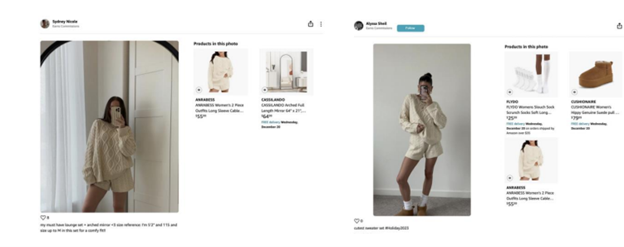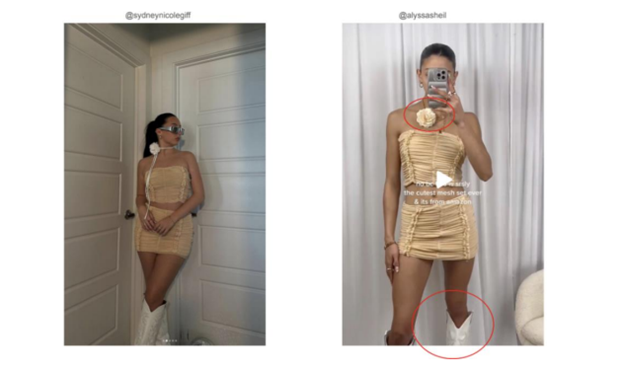The New York Times posed an interesting question in a recent article: “Can You Copyright a Vibe?”
A style of clothing or home decor that is popular on social media is often said to be “trending.” By definition, a style is “trending” if many social media users and influencers promote that style. And, if an influencer starts a trend that takes off, it’s considered a huge win. It seems, however, that at least one influencer is not happy when her trending style is copied too closely.
In Gifford v. Sheil, a case from the Western District of Texas, influencer Sydney Nicole Gifford sued fellow influencer Alyssa Sheil for copyright infringement based on Sheil’s alleged copying of “constituent elements” of Gifford’s works that are “original.” Gifford alleges that “in at least thirty photo posts across Defendant’s Platforms, Defendant has featured identical products featured in posts of Plaintiff’s Platforms with identical styling, tone, camera angle, and/or text.” The complaint includes the following images, with Gifford’s on the left and Sheil’s on the right. In these photos, Sheil is accused of promoting the same cream-colored sweater set as Gifford and including the same link to the product on Amazon.

The complaint also includes the following images, with Gifford’s on the left and Sheil’s on the right. Gifford explains that in this pair of photos, Sheil copied the pairing of the outfit with a flower clip around her neck and the cowboy boots.

The Decision
Following a motion by Sheil to dismiss some of the claims, Magistrate Judge Dustin M. Howell of the United States District Court for the Western District of Texas held that an influencer who copies another’s “aesthetic” or “makeup” may be infringing the other’s copyright or misappropriating the other’s image. Sheil had not moved to dismiss the claim for primary copyright infringement, and challenged only the subsidiary claims of secondary infringement and removal of copyright management information (CMI). Both of these claims rely on a preliminary finding of direct copyright infringement.
The Magistrate Judge acknowledged that “this case appears to be the first of its kind – one in which a social media influencer accuses another influencer of (among other things) copyright infringement based on the similarities between their posts that promote the same products,” but did not address the merits of that claim. He then recommended that the subsidiary claims should not be dismissed, implicitly acknowledging that there may be some merit to the primary claim of direct copyright infringement.
This decision may have opened the door for more complicated analyses of alleged copyright infringement online than we have seen to date. With this door opened, perhaps the creation of a “minimalist bathroom décor” board on Pinterest may be found to infringe another board with the same theme, or the creation of a social media page dedicated to promoting jewelry featuring the skull and cross-bones motif may be found to infringe an earlier-created page with the same theme. While these examples may appear extreme, once the door for “infringement based on … similarities between … posts that promote the same products” is opened, any post or page, no matter how careful an influencer is to create original content, may be a target for litigation.
The Magistrate Judge also recommended that the claim for misappropriation of likeness based on the alleged copying of “outfits, poses, hairstyles, makeup, and voice” not be dismissed. This decision would permit a claim of impersonation to be asserted against a social media influencer based on a personal style. Similar to claims of copyright infringement based on the amorphous concept of aesthetics, claims of impersonation based on the amorphous concept of personal style is a new frontier in social media internet law.
Analysis
Engaging in social media has always presented many legal pitfalls for the unwary. Influencers (and those who hire influencers) are often sued for copyright infringement based on the use of songs incorporated into their posts without licenses. Use of video snippets or photographs also often leads to suits for copyright infringement. This list of legal pitfalls, although far from complete, includes familiar types of intellectual property suits: copyright infringement based on actual copying of a protected work, violation of a right of publicity based on use of a celebrity’s actual likeness, and trademark infringement based on use of an actual trademark. The recent decision in Gifford v. Sheil may have just expanded this list of pitfalls and opened up a new era of intellectual property enforcement online.



 />i
/>i

